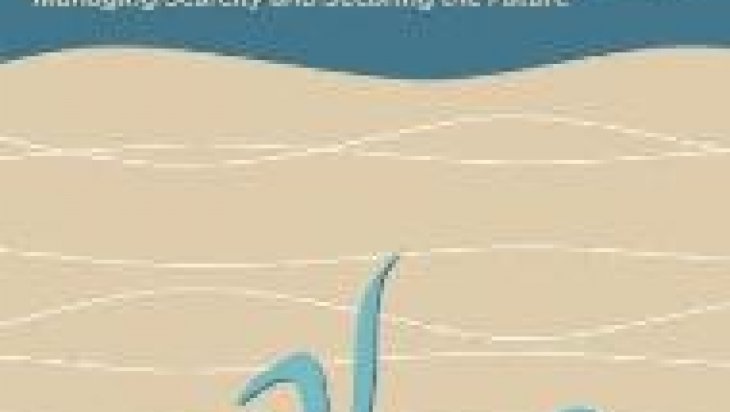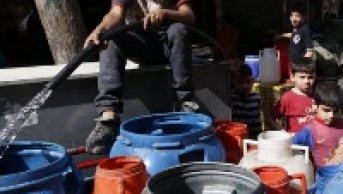UNDP Issues Report Titled ‘Water Governance in the Arab Region’

The Middle East is an arid/semi-arid zone. The region receives only 2.1 percent of the world’s average annual precipitation and contains 1.2 percent of annual renewable water resources. As can be seen from these figures, the quantity of renewable water resources is limited, and 65 percent of the region’s surface water resources originate from external areas. The overexploitation and unsustainable use of renewable and non-renewable water resources increases the risk of water scarcity. In this sense, the Middle East is usually the first region mentioned in the scenario of future water wars or conflicts.
The United Nations Development Programme (UNDP) on Nov. 30, 2013 issued a report on managing water scarcity and securing the future for Arab countries: Mauritania, Iraq, Comoros, Sudan and South Sudan, Somalia, Lebanon, Morocco, Syria, Egypt, Oman, Tunisia, Djibouti, Algeria, Palestine, Jordan, Libya, Bahrain, Saudi Arabia, Yemen, Qatar, the United Arab Emirates and Kuwait. According to the report, the Arab region contains 23 major watersheds. These include the Nile, Euphrates-Tigris, Jordan, Orontes, Nahr Al Kebir and Senegal basins. Furthermore, the report states that the estimated total dam capacity of the Arab region is 363.27 cubic kilometers. There are four leading countries in terms of dam capacity, which are as follows: Egypt (168.2 cubic kilometers), Iraq (151.8 cubic kilometers), Syria (19.7 cubic kilometers) and Morocco (16.9 cubic kilometers).
Another major water resource of the region is groundwater. Fifty percent of total waterneed is met by groundwater, corresponding to 84 percent in the Arabian Peninsula. The 15,000 to 25,000-year-old fossil aquifers are not included in the hydrological cycle. Namely, they are not renewed by precipitation or by rivers, unlike other groundwater resources. Therefore, they are exhaustible resources and should be used on a sustainable basis. The quality of groundwater resources, which are in danger of depletion due to overexploitation, is threatened by agricultural, industrial and domestic use.
On the other hand, groundwater resources in the region are largely non-renewable, and the majority of water need in the Arabian Peninsula and the Maghreb region is met by groundwater resources. The quality of groundwater resources, which are under risk due to overuse, is threatened by pollution from agricultural, industrial and domestic activities.
Another significant water resource in the Arab countries is desalination. The Arab region leads the world in desalination, with more than half of the world’s desalination capacity. In the Arab countries 24 million cubic meters of water are desalinated every day. The highest desalination capacity is in the Gulf countries. Of the water supplied to cities in the Gulf countries, 55 percent comes from desalinated water. However, the desalination process requires a large amount of energy and capital. The cost of one delivered cubic meter of desalinated water, ranging from $1.50 to $4, has dropped to an average $0.50–$0.80 per cubic meter due to new technologies, especially the reverse osmosis technique.
The report also draws attention to the water-energy-food nexus which has been the theme of several conferences held in recent years. The concerns of the aforementioned countries in particular regarding food security have increased the pressure and competition for water resources in the region. Grain imports of the Arab countries have doubled since 1990 despite the fact that some 80 percent of water resources were used for agricultural production. The report suggests that to achieve national food security, governments should improve agricultural productivity, maximize water productivity and provide regional agricultural integration with water, land and financial resources. Today, more than half of the food consumed in the Arab region is imported. It is expected to rise to 64 percent in the next two decades.
The water scarcity that prevails in the region has promoted desalination as an alternative resource, and this situation affects energy consumption. It is asserted that the annual growth rate of energy consumption in the region is 3-4 percent, twice the world average. On the other hand, electricity generation is growing at a rate of 6-8 percent a year, three times the world average. This rapid growth is mainly caused by subsidized electricity rates all across the countries of the region, as well as growing population, long dry spells and rapid urbanization.
Considering changes in the climate conditions, population and urbanization, the report suggests that by 2025 the water supply in the Arab region will be only 15 percent of its 1960 level. But the pessimistic picture could change through the achievement of water security. According to the UNDP report, the security of water resources, which are becoming more difficult to access with every day that passes, requires effective governance as well as good management principles and practices. It also depends on complex and rapidly changing social, economic, political and environmental circumstances. Furthermore, it should be stated that political will has a major role in providing effective governance and preparing a sound legal, institutional and economic infrastructure.
While population growth, rapid urbanization and climate change put more pressure on water resources in the Arab region, these factors also widen the gap between supply and demand. To meet the escalating water demand in the Middle East, water resources, both conventional (surface water and groundwater) and nonconventional (desalinated water, treated wastewater, rainwater harvesting, cloud seeding and irrigation drainage water), require efficient and sustainable management.
The key elements of good water governance are as follows: equity, transparency, accountability, environmental and economic sustainability, stakeholder participation and empowerment and responsiveness to socioeconomic development needs.
In addition, more than half of the conventional water resources of these countries are transboundary waters. Transboundary watercourses can cause problems for the region’s water-related governance. Above all, these shared resources lack comprehensive international agreements regarding transboundary waters. Mostly the agreements are either bilateral or limited, or sometimes no agreement is signed at all. The importance of cooperation with riparian states outside the region in order to use these resources equitably is also highlighted by the report.





